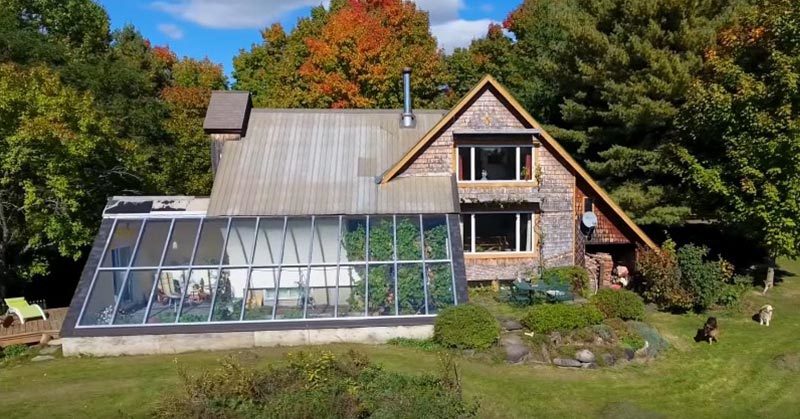The spring and summer is a wonderful time abundant with fresh produce. Unfortunately, as winter sets in we have to rely more heavily on imported fruits and vegetables that have traveled hundreds if not thousands of miles before they end up in our stores. This DIY heat storing greenhouse instead allows you to grow fresh produce all year long right in your own home.
DIY Heat Storing Greenhouse
Building yourself a heat storing greenhouse may seem like an expensive, daunting task but I promise you it is more achievable than you think. Depending on your level of building expertise, you can either purchase a lean-to greenhouse kit or you can source your own materials and do a complete DIY.
Either way you choose, there are several items you will want to consider before starting.
Green House Location
This is one of the best parts about a lean-to heat storing greenhouse: It fits right up against your house, so you won’t have to walk far to get to it. Expense is another pro, as a lean-to greenhouse requires one less wall. This helps to cut back on material costs. Bonus points if you have an L-shaped wall, as that means yet another wall you won’t have to build. (1)
Another benefit is that you will have quicker and easier access to water and electricity, two things you will definitely need to make your plants grow. (2)
You’ll also want to choose the side of your house that gets the most sun. If none of the sun-filled walls of your home are good enough, then you will want to look at building a stand-alone greenhouse in your yard instead. If you don’t have enough sun shining in, the greenhouse won’t get warm enough and the plants won’t receive adequate sunshine to grow. (1) The location of your greenhouse should get at least six hours of sunlight during the wintertime. (2)
Space and Size
Think about how many plants you want to grow and how much space you are going to need. Start with how much height and square footage you think you want, then add more. (1) Greenhouses are a long-term project and most owners end up having to build additional space down the line. (2)
That being said, proper planning can allow you to grow plenty of plants in a smaller space. Using items like benches, tables, hanging and climbing plants can allow you to fit up to 100 plants in an 8 x 10-foot greenhouse. (1)
Roof and Wall Design of the Greenhouse
The first thing to consider here is the glazing. You’ve got three options for this, all of which have their pros and cons.
- Glass
This is the best material for glazing and is the longest-lasting, however, it is the most expensive. (2) - Plastic sheeting
This is the least expensive however it will deteriorate over time and you will have to replace it more frequently. (2) - Polycarbonate
In between glass and plastic in terms of price, polycarbonate does the best job at retaining heat. It is also durable and lightweight and can be used on both flat and bent surfaces. (2)
In terms of the toplight (the roof), it is important to note that making this out of glass will let in a huge amount of light. This will be too hot for your plants in the summertime. Most plants only need about 30% top light to grow, so you want to either build your greenhouse with something less transparent or have a shade set up for the warm summer months. (1)
Shading can be made of (2):
- Polypropylene shade cloth
- Wood or aluminium roll-up screens
- Vinyl plastic shading
- Paint-on materials
Ventilation
If it is apparent already, temperature control in a greenhouse is critical to the success of your plants. You will need to install vents in your greenhouse. (2) They can be (2):
- Hand crank-operated
- Automatic, temperature-sensitive hydraulic
The hand-crank ones will require you to closely monitor the temperature, the temperature-sensitive ones monitor it for you and automatically open and close. Another good idea, whichever vent type you choose, is to install a fan. This will improve air circulation and prevent disease problems. (2)
Materials
There are a variety of materials you need to build your own heat storing greenhouse.
For the Floor
There are several options for your greenhouse floor. These include (1):
- Concrete: inexpensive and you can pour it yourself
- Bricks and sand: A level base of sand with bricks laid on top. More expensive than concrete but easier to do.
- Cinder and gravel: Can be spread directly on the ground and be several inches deep. This option is best used as a temporary one only.
Walls and More
The cost of building the rest of your greenhouse depends largely on how you choose to go about it. You can buy brand-new lumber and sashes, or you can choose to use recycled doors, windows, boards, and beams. (1)
Check Local Building Codes
As always before you start any DIY home-build projects, check with your local building codes before you start. This will help you avoid a lot of headaches and heartache later on. (1)
It is also important to note that there are certain aspects of building greenhouses, such as forms and foundation, that inexperienced builders are better off hiring a professional. The last thing you want is for your greenhouse to collapse on you. (1)
Heat Storing Greenhouse: The Bottom Line
Having an at-home heat storing greenhouse is highly rewarding for more reasons that just the joy of fresh produce all year round. Having one yourself also doesn’t have to be an overly expensive endeavor. With proper planning and construction, you can have your very own heat storing greenhouse right in your own backyard.
Keep Reading: 640-Square-Foot Solar-Powered Shipping Container House with Greenhouse for $25,000

